Mainz
| Mainz | |
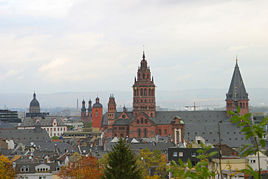 |
|
| Coat of arms | Location |
 |
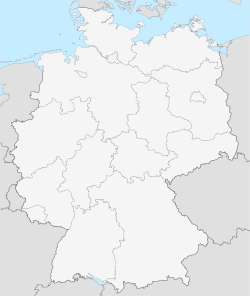 |
| Administration | |
| Country | Germany |
|---|---|
| State | Rhineland-Palatinate |
| District | Urban district |
| City subdivisions | 15 boroughs |
| Lord Mayor | Jens Beutel (SPD) |
| Basic statistics | |
| Area | 97.75 km² (37.7 sq mi) |
| Elevation | 85-285 m |
| Population | 200,234 (29/07/2007)[1] |
| - Density | 2,048 /km² (5,305 /sq mi) |
| Founded | 13 BC |
| Other information | |
| Time zone | CET/CEST (UTC+1/+2) |
| Licence plate | MZ |
| Postal codes | 55001-55131 |
| Area codes | 06131, 06136 |
| Website | www.mainz.de |
Mainz (IPA: [ˈmaɪ̯nʦ]) (French: Mayence) is a city in Germany and the capital of the German federal state of Rhineland-Palatinate. It was a politically important seat of the Prince-elector of Mainz (see: Archbishopric of Mainz) under the Holy Roman Empire, and previously was a Roman fort city which commanded the west bank of the Rhine and formed part of the northernmost frontier of the Roman Empire.
Mainz is a city with over two thousand years of history. It is located on the river Rhine across from Wiesbaden, in the western part of the Frankfurt Rhine-Main Region; in the modern age, Frankfurt shares much of its regional importance.
Contents |
Geography
Mainz is located on the west bank of the river Rhine, opposite the confluence of the Main with the Rhine. The 2007 population was 200,234; an additional 18,619 people maintain a primary residence elsewhere but have a second home in Mainz and it is also a part of the Rhein Metro area consisting of 5.8 million people. Mainz is easily reached from Frankfurt International Airport in 25 minutes by commuter railway (Rhine-Main S-Bahn).
The city consists of 15 districts: Altstadt, Neustadt, Mombach, Gonsenheim, Hartenberg-Münchfeld, Oberstadt, Bretzenheim, Finthen, Drais, Lerchenberg, Marienborn, Hechtsheim, Ebersheim, Weisenau, and Laubenheim. Until 1945, the districts of Bischofsheim (now an independent town), Ginsheim-Gustavsburg (which together are an independent town) belonged to Mainz. The former suburbs Amöneburg, Kastel, and Kostheim—in short AKK—now are administrated by the city of Wiesbaden (on the north bank of the river). The AKK was separated from Mainz when the Rhine was designated the boundary between the French occupation zone (the later state of Rhineland-Palatinate) and the U.S. occupation zone (Hesse) in 1945.
Administrative structure
The city of Mainz is divided into 15 local districts according to the main statute of the city of Mainz. Each local district has a district administration of 13 members and a directly elected mayor, who is the chairmen of the district administration. This local council decides on important issues affecting the local area, however, the final decision on new policies is made by the Mainz's municipal council.
In accordance with § 29 Par. 2 of Local Government Regulations, which refers to municipalities of more than 150,000 inhabitants, the city council has 60 members.
Districts of the town are:
|
|
|
Former districts (until the end of WWII):
- Mainz-Amöneburg, Mainz-Kastel, Mainz-Kostheim, Mainz-Bischofsheim and Mainz-Gustavsburg
Coat of arms
The coat of arms of Mainz is derived from the coat of arms of the Archbishops of Mainz and features two six-spoked silver wheels connected by a silver cross on a red background.
History
Roman Moguntiacum
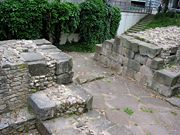
The Roman stronghold of castrum Moguntiacum, the precursor to Mainz, was founded by the Roman general Drusus perhaps as early as 13 BC. As related by Suetonius the existence of Moguntiacum is well established by four years later (the account of the death and funeral of Nero Claudius Drusus), though several other theories suggest the site may have been established earlier.[2] Although the city is situated opposite the mouth of the Main river, the name of Mainz is not from Main, the similarity being perhaps due to diachronic analogy. Main is from Latin Menus, the name the Romans used for the river. Linguistic analysis of the many forms that the name "Mainz" has taken on, make it clear that it is a simplification of Moguntiacum.
The name appears to be Celtic and ultimately it is from the Celtic. However, it also had become Roman and was selected by the Romans with a special significance. The Roman soldiers defending Gallia had adopted the Gallic god Mogons (Mogounus, Moguns, Mogonino), for the meaning of which etymology offers two basic options: "the great one", similar to Latin magnus, which was used in aggrandizing names such as Alexander magnus, "Alexander the Great" and Pompeius magnus, "Pompey the great", or the god of "might" personified as it appears in young servitors of any type whether of noble or ignoble birth.[3]

To name the fort after this particular god was an ideological statement. It was placed in the territory of the Vangiones, a formerly Germanic tribe now Celticised and working for the Romans. Their capital was at Worms on the same side of the Rhine not far to the south. Dedications of their troops serving in Britain mention the god frequently. Germania Superior was a geographical gateway between Gaul and Germany. The Romans were saying in essence by placing the fort here and naming it that "You barbarians shall not pass into the civilized and international state because the might of its youth inspired by its ancient god will stop you." If the barbarians needed any example, the previous fate of the Vangiones, who had come as conquerors and were conquered, was before them.
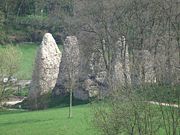
Moguntiacum was an important military town throughout Roman times, probably due to its strategic position at the confluence of the Main and the Rhine. The town of Moguntiacus grew up between the fort and the river. The castrum was the base of Legio XIIII Gemina and XVI Gallica (AD 9–43), XXII Primigenia, IIII Macedonica (43–70), I Adiutrix (70-88), XXI Rapax (70-89), and XIIII Gemina (70–92), among others. Mainz was also the base of a Roman river fleet (the remains of Roman patrol boats and cargo barges from about 375/6 were discovered in 1982 and may now be viewed in the Museum für Antike Schifffahrt). The city was the provincial capital of Germania Superior, and had an important funeral monument dedicated to Drusus, to which people made pilgrimages for an annual festival from as far away as Lyon. Among the famous buildings were the largest theatre north of the Alps and a bridge across the rhine.
Alamanni forces under Rando sacked the city in 368. In last days of 406, the Siling and Asding Vandals, the Suebi, the Alans, and other Germanic tribes took advantage of the rare freezing of the Rhine to cross the river at Mainz and overwhelm the Roman defences. Christian chronicles relate that the bishop, Aureus, was put to death by the Alamannian Crocus. The way was open to the sack of Trier and the invasion of Gaul. This event is familiar to many from the historical novel, Eagle in the Snow, by Wallace Breem.
Throughout the changes of time, the Roman castrum never seems to have been permanently abandoned as a military installation, which is a testimony to Roman military judgement. Different structures were built there at different times. The current citadel originated in 1660, but it replaced previous forts. It was used in World War II. One of the sights at the citadel is still the cenotaph raised by his legionaries to commemorate Drusus.
Frankish Mainz
Through a series of incursions during the 4th century Alsace gradually lost its Belgic ethnic character of formerly Germanic tribes among Celts ruled by Romans and became predominantly influenced by the Alamanni. The Romans repeatedly reasserted control; however, the troops stationed at Mainz became chiefly non-Italic and the emperors had only one or two Italian ancestors in a pedigree that included chiefly peoples of the northern frontier.
The last emperor to station troops serving the western empire at Mainz was Valentinian III, who relied heavily on his Magister militum per Gallias, Flavius Aëtius. By that time the army included large numbers of troops from the major Germanic confederacies along the Rhine, the Alamanni, the Saxons and the Franks. The Franks were an opponent that had risen to power and reputation among the Belgae of the lower Rhine during the 3rd century and repeatedly attempted to extend their influence upstream. In 358 the emperor Julian bought peace by giving them most of Germania Inferior, which they possessed anyway, and imposing service in the Roman army in exchange.
The European chessboard in the time of master Aëtius included Celts, Goths, Franks, Saxons, Alamanni, Huns, Italians, and Alans as well as numerous minor pieces. Aëtius played them all off against one another in a masterly effort to keep the peace under Roman sovereignty. He used Hunnic troops a number of times. At last a day of reckoning arrived between Aëtius and Attila, both commanding polyglot, multi-ethnic troops. Attila went through Alsace in 451, devastating the country and destroying Mainz and Triers with their Roman garrisons. Shortly after he was stalemated by Flavius Aëtius at the Battle of Chalons, the largest of the ancient world.
Aëtius was not to enjoy the victory long. He was assassinated by his employer's own hand in 454, who was himself stabbed to death by friends of Aëtius in 455. As far as the north was concerned this was the effective end of the Roman empire there. After some sanguinary but relatively brief contention a former subordinate of Aëtius, Ricimer, became emperor, taking the name Patrician. His father was a Suebian; his mother, a princess of the Visigoths. Patrician did not rule the north directly but set up a client province there, which functioned independently. The capital was at Soissons. Even then its status was equivocal. Many insisted it was the Kingdom of Soissons.
Previously the first of the Merovingians, Clodio, had been defeated by Aëtius at about 430. His son, Merovaeus, fought on the Roman side against Attila, and his son, Childeric, served in the domain of Soissons. Meanwhile the Franks were gradually infiltrating and assuming power in this domain. They also moved up the Rhine and created a domain in the region of the former Germania Superior with capital at Cologne. They became known as the Ripuarian Franks as opposed to the Salian Franks. It is unlikely that much of a population transfer or displacement occurred. The former Belgae simply became Franks.
Events moved rapidly in the late 5th century. Clovis, son of Childeric, became king of the Salians in 481, ruling from Tournai. In 486 he defeated Syagrius, last governor of the Soissons domain, and took northern France. He extended his reign to Cambrai and Tongeren in 490-491, and repelled the Alamanni is 496. Also in that year he converted to non-Arian Christianity.
After the Fall of the Roman Empire in 476, the Franks under the rule of Clovis I gained control over western Europe by the year 496. Clovis annexed the kingdom of Cologne in 508. Thereafter, Mainz, in its strategic position, became one of the bases of the Frankish kingdom. Mainz had sheltered a Christian community long before the conversion of Clovis. His successor Dagobert reinforced the walls of Mainz and made it one of his seats. A solidus of Theodebert I (534-548) was minted at Mainz.
The Franks united the Celtic and Germanic tribes of Europe. The greatest Frank of all was Charlemagne (768-814), who built a new empire in Europe, the Holy Roman Empire. Mainz from its central location became important to the empire and to Christianity. Meanwhile language change was gradually working to divide the Franks. Mainz spoke a dialect termed Ripuarian. On the death of Charlemagne, distinctions between France and Germany began to be made. Mainz was not central any longer but was on the border, creating a question of the nationality to which it belonged, which descended into modern times as the question of Alsace-Lorraine.
Christian Mainz
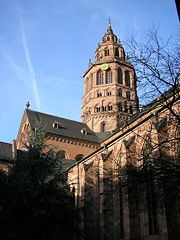

In the early Middle Ages, Mainz was a centre for the Christianisation of the German and Slavic peoples. The first Archbishop in Mainz, Boniface, was killed in 754 while trying to convert the Frisians to Christianity and is buried in Fulda. Other early archbishops of Mainz include Rabanus Maurus, the scholar and author, and Willigis (975–1011), who began construction on the current building of the Mainz Cathedral and founded the monastery of St. Stephan.
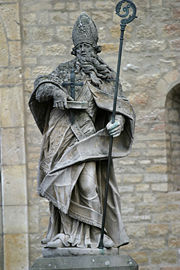
From the time of Willigis until the end of the Holy Roman Empire in 1806, the Archbishops of Mainz were archchancellors of the Empire and the most important of the seven Electors of the German emperor. Besides Rome, the diocese of Mainz today is the only diocese in the world with an episcopal see that is called a Holy See (sancta sedes). The Archbishops of Mainz traditionally were primas germaniae, the substitutes of the Pope north of the Alps.
In 1244, Archbishop Siegfried III granted Mainz a city charter, which included the right of the citizens to establish and elect a city council. The city saw a feud between two Archbishops in 1461, namely Diether von Isenburg, who was elected Archbishop by the cathedral chapter and supported by the citizens, and Adolf II von Nassau, who had been named Archbishop for Mainz by the Pope. In 1462, the Archbishop Adolf II raided the city of Mainz, plundering and killing 400 inhabitants. At a tribunal, those who had survived lost all their property, which was then divided between those who promised to follow Adolf II. Those who would not promise to follow Adolf II (amongst them Johann Gutenberg) were driven out of the town or thrown into prison. The new Archbishop revoked the city charter of Mainz and put the city under his direct rule. Ironically, after the death of Adolf II his successor was again Diether von Isenburg, now legally elected by the chapter and named by the Pope.
Early Jewish community
The Jewish community of Mainz dates to the 10th century CE. It is noted for its religious education. Rabbi Gershom ben Judah (960-1040) taught there, among others. He concentrated on the study of the Talmud, creating a German Jewish tradition. The Jews of Mainz, Speyer and Worms created a supreme council to set standards in Jewish law and education in the 12th century.
The city of Mainz responded to the Jewish population in a variety of ways, behaving, in a sense, in a bipolar fashion towards them. Sometimes they were allowed freedom and were protected; at other times, they were persecuted. For example, they were expelled in 1462, invited to return, and expelled again in 1474. Outbreaks of the Black Death were usually blamed on the Jews, at which times they were massacred. This unstable pattern, which was not typical for Mainz only, but for whole Europe at that time, went on until World War II.
Nowadays the Jewish community is growing rapidly, and is considering the creation of a new synagogue.[4] The community itself has 1,034 members, according to the Central Council of Jews in Germany, and at least twice as many Jews altogether since many are unaffiliated with Judaism.
Republic of Mainz
During the French Revolution, the French Revolutionary army occupied Mainz in 1792; the Archbishop of Mainz, Friedrich Karl Josef von Erthal, had already fled to Aschaffenburg by the time the French marched in. On 18 March 1793, the Jacobins of Mainz, with other German democrats from about 130 towns in the Rhenish Palatinate, proclaimed the ‘Republic of Mainz’. Led by Georg Forster representatives of the Mainz Republic in Paris requested political affiliation of the Mainz Republic with France, but too late: As Prussia was not entirely happy with the idea of a democratic free state on German soil, Prussian troops had already occupied the area and besieged Mainz by the end of March, 1793. After a siege of 18 weeks, the French troops in Mainz surrendered on 23 July 1793; Prussians occupied the city and ended the Republic of Mainz. Members of the Mainz Jacobin Club were mistreated or imprisoned and punished for treason.

In 1797, the French returned. The army of Napoléon Bonaparte occupied the German territory to the west of the Rhine river, and the Treaty of Campo Formio awarded France this entire area. On 17 February 1800, the French Département du Mont-Tonnerre was founded here, with Mainz as its capital, the Rhine river being the new eastern frontier of la Grande Nation. Austria and Prussia could not but approve this new border with France in 1801. However, after several defeats in Europe during the next years, the weakened Napoléon and his troops had to leave Mainz in May 1814.
Hessian Mainz
In 1816, the part of the former French Département which is known today as Rhenish Hesse (German: Rheinhessen) was awarded to the Hesse-Darmstadt, Mainz being the capital of the new Hessian province of Rhenish Hesse. From 1816 to 1866, to the German Confederation Mainz was the most important fortress in the defence against France, and had a strong garrison of Austrian and Prussian troops.
In the afternoon of 18 November 1857, a huge explosion rocked Mainz when the city’s powder magazine, the Pulverturm, exploded. Approximately 150 people were killed and at least 500 injured; 57 buildings were destroyed and a similar number severely damaged in what was to be known as the Powder Tower Explosion or Powder Explosion.
During the Austro-Prussian War in 1866, Mainz was declared a neutral zone. After the founding of the German Empire in 1871, Mainz no longer was as important a stronghold, because in the war of 1870/71 France had lost the territory of Alsace-Lorraine to Germany, and this defined the new border between the two countries.
Industrial expansion

For centuries the inhabitants of the fortress of Mainz had suffered from a severe shortage of space which led to disease and other inconveniences. In 1872 Mayor Carl Wallau and the council of Mainz persuaded the military government to sign a contract to expand the city. Beginning in 1874, the city of Mainz assimilated the Gartenfeld, an idyllic area of meadows and fields along the banks of the Rhine River to the north of the rampart. The city expansion more than doubled the urban area which allowed Mainz to participate in the industrial revolution which had previously avoided the city for decades.

Eduard Kreyßig was the man who made this happen. Having been the master builder of the city of Mainz since 1865, Kreyßig had the vision for the new part of town, the Mainz Neustadt. He also planned the first sewer system for the old part of town since Roman times and persuaded the city government to relocate the railway line from the Rhine side to the west end of the town. The main station was built from 1882 to 1884 according to the plans of Philipp Johann Berdellé (1838–1903).
The Mainz master builder constructed a number of state-of-the-art public buildings, including the Mainz town hall — which was the largest of its kind in Germany at that time — as well a synagogue, the Rhine harbour and a number of public baths and school buildings. Kreyßig's last work was Christ Church (Christuskirche), the largest Protestant church in the city and the first building constructed solely for the use of a Protestant congregation.
In the 20th century
After World War I the French occupied Mainz between 1919 and 1930 according to the Treaty of Versailles which went into effect 28 June 1919. The Rhineland (in which Mainz is located) was to be a demilitarized zone until 1935 and the French garrison, representing the Triple Entente, was to stay until reparations were paid.
In 1923 Mainz participated in the Rhineland separatist movement that proclaimed a republic in the Rhineland. It collapsed in 1924. The French withdrew on 30 June 1930. Adolf Hitler became chancellor of Germany in January, 1933 and his political opponents, especially those of the Social Democratic Party, were either incarcerated or murdered. Some were able to move away from Mainz in time. One was the political organizer for the SPD, Friedrich Kellner, who went to Laubach, where as the chief justice inspector of the district court he continued his opposition against the Nazis by recording their misdeeds in a 900-page diary.
In March, 1933, a detachment from the National Socialist Party in Worms brought the party to Mainz. They hoisted the swastika on all public buildings and began to denounce the Jewish population in the newspapers. In 1936 the forces of the Third Reich reentered the Rhineland with a great fanfare, the first move of the Third Reich's meteoric expansion. The former Triple Entente took no action.
During World War II the citadel at Mainz hosted the Oflag XII-B prisoner of war camp.
The Bishop of Mainz formed an organization to help Jews escape from Germany.
During World War II, more than 30 air raids destroyed about 80 percent of Mainz city centre, including most of the historic buildings. Mainz fell to XII Corps, 90th Division, of the Third Army under the command of General George S. Patton, Jr. on 22 March 1945. Patton used the ancient strategic gateway through Germania Superior to cross the Rhine south of Mainz, drive down the Danube towards Czechoslovakia and end the possibility of a Bavarian redoubt crossing the Alps in Austria when the war ended. With regard to the Roman road over which Patton attacked Trier, he said:[5]
one could almost smell the coppery sweat and see the low dust clouds where those stark fighters moved forward into battle.
From 1945 to 1949, the city was part of the French zone of occupation. When the federal state of Rhineland-Palatinate was founded on 18 May 1947, Koblenz was the temporary capital; in 1950 Mainz became the capital of the new state. In 1962, the diarist, Friedrich Kellner, returned to spend his last years in Mainz. His life in Mainz, and the impact of his writings, is the subject of the Canadian documentary My Opposition: the Diaries of Friedrich Kellner.
Following the withdrawal of French forces from Mainz, the U.S. Army Europe occupied the military bases in Mainz. Today USAREUR only occupies McCulley Barracks in Wackernheim and the Mainz Sand Dunes for training area. Mainz is home to the headquarters of the Bundeswehr's Wehrbereichskommando II and other units.
Community
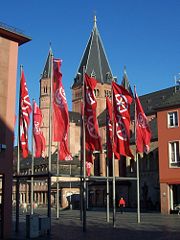
Culture
- As city in the Greater Region, Mainz participated in the program of the year of European Capital of Culture 2007.
- The Walk of Fame of Cabaret may be found nearby the Schillerplatz.
- The music publisher Schott Music is located in Mainz.
- The one of the oldest brass instrument manufacturer in the world, Gebr. Alexander is located in Mainz.
Sport
The local football club 1. FSV Mainz 05 has a long history in the German football leagues. It is currently intending to build a new stadion called Coface Arena. In 2007 the Mainz Athletics won the German Men's Championsship in baseball. As a result of the 2008 invasion of Georgia by Russian troops, Mainz acted as a neutral venue for the Geogian Vs Republic of Ireland football game
Attractions

- Roman-Germanic central museum (Römisch-Germanisches Zentralmuseum). It is home to Roman, Medieval, and earlier artifacts.
- Antique Maritime Museum (Museum für Antike Schifffahrt). It houses the remains of five Roman boats from the late 4th century, discovered in the 1980s.
- Roman remains, including Jupiter's column, Drusus' mausoleum, the ruins of the theatre and the aqueduct.
- Mainz Cathedral of St. Martin (Mainzer Dom), over 1,000 years old.
- The Iron Tower (Eisenturm, tower at the former iron market), a tower from the 13th century.
- The Wood Tower (Holzturm, tower at the former wood market), a tower from the 14th century.
- The Gutenberg Museum – exhibits an original Gutenberg Bible amongst many other printed books from the 15th century and later.
- The Mainz Old Town – what's left of it, the quarter south of the cathedral survived World War II.
- The Electoral Palace (Kurfürstliches Schloss), residence of the prince-elector .
- Marktbrunnen, one of the largest Renaissance fountains in Germany.
- Domus Universitatis (1615), for centuries the tallest edifice in Mainz.
- Christ Church (Christuskirche), built 1898–1903, bombed in ’45 and rebuilt in 1948–1954.
- The Church of St. Stephan, with post-war windows by Marc Chagall.
- Citadel.
- Schönborner Hof (1668).
- Rococo churches of St. Augustin (the Augustinerkirche, Mainz) and St. Peter (the Petruskirche, Mainz).
- Church of St. Ignatius (1763).
- Erthaler Hof (1743).
Economy
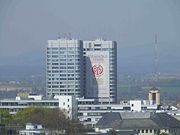
Wine centre
Mainz is one of the centers of the German wine economy[6]as a center for wine trade and the seat of the state's wine minister. Due to the importance and history of the wine industry for the federal state, Rhineland-Palatinate is the only state to have such a department. Many wine traders also work in the town. The sparkling wine producer Kupferberg produces in Mainz-Hechtsheim and even Henkell - now located on the other side of the river Rhine - had been founded once in Mainz. The famous Blue Nun, one of the first branded wines, had been marketed by the family Sichel.
Mainz had been a wine growing region since Roman times and the image of the wine town Mainz is fostered by the tourist center. The Haus des Deutschen Weines (English: House of the German Wine), is located in beside the theater. It is the seat of the German Wine Academy, the German Wine Institute (DWI) and the German Wine Fund (DWF). The Mainzer Weinmarkt (wine market) is one of the great wine fairs in Germany.
Other industries
The Schott AG, one of the world's largest glass manufactures, as well as the Werner & Mertz GmbH, a large chemical factory, are based in Mainz. Other companies such as IBM or Novo Nordisk have their German administration in Mainz as well.
Johann-Joseph Krug, founder of France's famous Krug champagne house in 1843, was born in Mainz in 1800.
The Port of Mainz, now handling mainly containers, is a sizable industrial area to the north of the city, along the banks of the Rhine. It will soon shift further northwards to open up space along the city's riverfront for residential development.
Miscellaneous
After the last ice age, sand dunes were deposited in the Rhine valley at what was to become the western edge of the city. The Mainz Sand Dunes area is now a nature reserve with a unique landscape and rare steppe vegetation for this area.

Johannes Gutenberg, credited with the invention of the modern printing press with movable type, was born here and died here. The Mainz University, which was refounded in 1946, is named after Gutenberg; the earlier University of Mainz that dated back to 1477 had been closed down by Napoleon's troops in 1798.
Mainz was one of three important centers of Jewish theology and learning in Central Europe during the Middle Ages. Known collectively as Shum, the cities of Speyer, Worms and Mainz played a key role in the preservation and propagation of Talmudic scholarship. (See also: Gershom ben Judah)
Mainz is famous for its Carnival, the Mainzer Fassenacht or Fassnacht, which has developed since the early 19th century. Carnival in Mainz has its roots in the criticism of social and political injustices under the shelter of cap and bells; today, the uniforms of many traditional Carnival clubs still imitate and caricature the uniforms of the French and Prussian troops of the past. The height of the carnival season is on Rosenmontag ("rose Monday", before Ash Wednesday), when there is a large parade in Mainz, with more than 500,000 people celebrating in the streets.
The first ever Katholikentag, a festival-like gathering of German Catholics, was held in Mainz in 1848.
The city is well-known in Germany as the seat of Zweites Deutsches Fernsehen (literally, "Second German Television", ZDF), one of two federal nationwide TV broadcasters. There are also a couple of radio stations based in Mainz.
According to legend, Mainz is the supposed birthplace of Pope Joan (John Anglicus), the woman who, disguised as a man, was elected pope, and served for two years during the Middle Ages.
Notable people
- List of people related to Mainz
- Archbishops of Mainz
- List of mayors of Mainz
Twinning
Mainz is twinned with:
|
Alternative names
Mainz is called by a number of different names in other languages and dialects. These include: Määnz (formerly Meenz) in the local West Middle German dialect, and Mentz in English or Mayence in French. The latter name was also used in English, but this usage of Mayence has almost completely disappeared, although Google Maps and Google Earth are using it. Other names for this city are: Magonza (Italian), Maguncia (Spanish), Majnc (Serbian), Mogúncia (Portuguese), Moguncja (Polish), Moguntiacum (Latin), and Mohuč (Czech, Slovak).
See also
References and notes
- ↑ Landeshauptstadt Mainz. "Einwohner_nach_Stadtteilen" (PDF) (in German). Retrieved on 2007-04-25.
- ↑ The earliest certain evidence of the existence of Moguntiacum is the account of the death and funeral of Nero Claudius Drusus, brother of the future emperor, Tiberius, given in Suetonius' life of Drusus. Few leaders have been as loved and as popular as Drusus. He fell from his horse in 9 BCE, contracted gangrene and lingered several days. His brother Tiberius reached him in just a few days riding post-horses over the Roman roads and served as the chief mourner, walking with the deceased in a funeral procession from the summer camp where he had fallen to Moguntiacum, where the soldiers insisted on a funeral. The body was transported to Rome, cremated in the Campus Martis and the ashes placed in the tomb of Augustus, who was still alive, and wrote poetry and delivered a state funeral oration for him. If Drusus founded Moguntiacum the earliest date is the start of his campaign, 13 BCE. Some hypothesize that Moguntiacum was constructed at one of two earlier opportunities, one when Marcus Agrippa campaigned in the region in 42 BCE or by Julius Caesar himself after 58 BCE. Lack of evidence plays a part in favoring 13 BCE. No sources cite Moguntiacum before 13 BCE, no legions are known to have been stationed there, and no coins survive.
- ↑ A second hypothesis suggests that Moguns was a wealthy Celtic person whose estate was taken for the fort and that a tax district was formed on the area parallel to other tax districts with a -iacum suffix (Arenacum, Mannaricium). One difficulty is that there is no evidence for the wealthy man or his estate, but there is plenty of evidence for the god. According to Carl Darling Buck in Comparative Grammar of Greek and Latin, -yo- and -k- are general Indo-European formative suffices and are not related to taxes. As the loyalty of the Vangiones was unquestioned and Drusus was campaigning over the Rhine, it is unlikely Moguntiacum would have been built to collect taxes from the Vangiones, who were not a Roman municipium.
- ↑ de:Neue Synagoge Mainz
- ↑ George S. Patton, War as I Knew It
- ↑ Culture and History (from the Mainz city council website. Accessed 2008-02-10.)
Further reading
- Denis B. Saddington: The stationing of auxiliary regiments in Germania Superior in the Julio-Claudian period.
- Valerie M. Hope: Constructing Identity: The Roman Funerary Monuments of Aquelia, Mainz and Nimes; British Archaeological Reports (16. Juli 2001) ISBN 978-1841711805
- Michael Imhof, Simone Kestin: Mainz City and Cathedral Guide. Michael Imhof Verlag; (15. September 2004) ISBN 978-3937251936
External links
- The official web site of the city of Mainz
- Mainz Area English & French Speaking Community
- Mainz City Panoramas — Panoramic Views and virtual Tours
- Mogons
- The Mainz Sand Dunes
- The Citadel
- Roman Mainz with a picture section
- The International Bookfair of Mainz
|
|||||||
|
||||||||